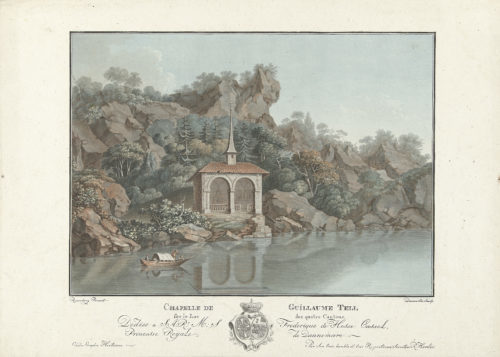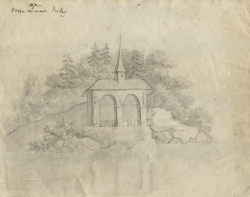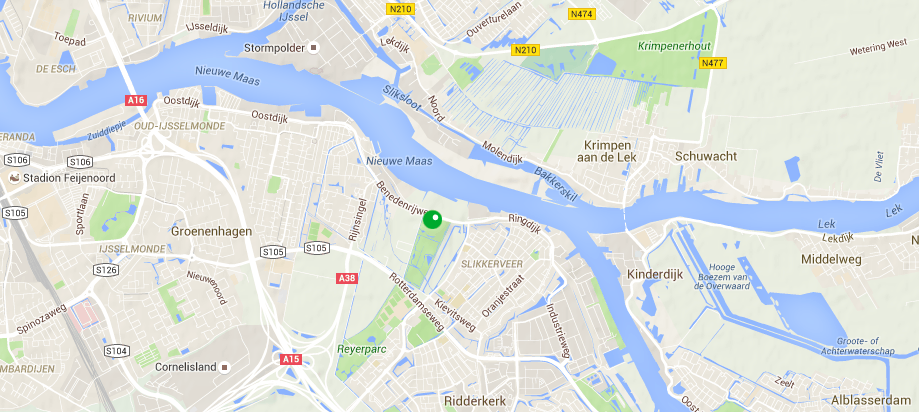Last November I wrote (in Dutch) about the creation date of a pavilion in the garden of Huys ten Donck: the chapel of Wilhelm Tell.1The building was referred to in a cash register as het Capelleke Buyten, which roughly translates into ‘the small chapel (way) out (in the garden)’. I showed a c1815 drawing of the chapel of Wilhelm Tell, made by one of the Groeninx van Zoelen children and now stored in the archive of Huys ten Donck. And I then wrote something along these lines: probably drawn in situ, as the family visited Switzerland quite extensively in 1811-1812.
What was I thinking? Sure, it was a possibility, looking at the time lines. But of course the real source was somewhere else. Here source and copy are shown together:
Left: a screenshot (better image here) from Vues remarquables des montagnes de la Suisse, dessinées et peintes d’apres nature, avec leur description, c1785;
Right: a drawing by Elisabeth Cornelie Groeninx van Zoelen, c1815(?)
(Photo: Stadsarchief Rotterdam).
After confirming the 1792 construction date of this garden building at Huys ten Donck (preceding a family trip to Switzerland and the creation of the drawing by around 20 years), I still had to know what the source of the design was. How did the Groeninx van Zoelen family know what it looked like?
Enter this publication: Vues remarquables des montagnes de la Suisse, dessinées et peintes d’apres nature, avec leur description, featuring the image of this chapel shown here (above left).2Published in Amsterdam by Rudolph Hentzi, printed by Yntema in 1785. Drawing: Johann Georg Rosenberg; engraving by Charles Melchior Descourtis. If this print, part of a book that was printed in Amsterdam, was not the primary source for at least the drawing of the chapel, I don’t know what was.
Whether or not it was the source for the design of the building, is not clear. Nor do we know whether the book was bought by the family. But the large plates were often taken from the book and used as individual works of art.3The sheet measures 47×33 cm, the print itself 32×23 cm. Not only for the usual reseller bonus, but also by the original buyers, who apparently used these plates as wall decoration, or applied them as decorative elements on (for example) room dividers.4J.C. Bierens de Haan, Rosendael. Groen Hemeltjen op Aerd (s.l. 1994), p.186 and p.273, n.113. The book was probably available in the library of Rosendael (near Arnhem) in the late 18th century, purchased under the name Switsersche Gesichten (‘Swiss vues’). It is said that at Marquette, in Heemskerk (north of Amsterdam), these plates were used as decorative elements in the interior of the rooms.
Whether the book was purchased by the Groeninx van Zoelen family, is not known at this stage.
Certainly, at least one family member had access to this particular print in one way or another.
Location of Huys ten Donck, southeast of Rotterdam.
Footnotes
| ↑1 | The building was referred to in a cash register as het Capelleke Buyten, which roughly translates into ‘the small chapel (way) out (in the garden)’. |
|---|---|
| ↑2 | Published in Amsterdam by Rudolph Hentzi, printed by Yntema in 1785. Drawing: Johann Georg Rosenberg; engraving by Charles Melchior Descourtis. |
| ↑3 | The sheet measures 47×33 cm, the print itself 32×23 cm. |
| ↑4 | J.C. Bierens de Haan, Rosendael. Groen Hemeltjen op Aerd (s.l. 1994), p.186 and p.273, n.113. The book was probably available in the library of Rosendael (near Arnhem) in the late 18th century, purchased under the name Switsersche Gesichten (‘Swiss vues’). It is said that at Marquette, in Heemskerk (north of Amsterdam), these plates were used as decorative elements in the interior of the rooms. Whether the book was purchased by the Groeninx van Zoelen family, is not known at this stage. |






Mooi Henk, hier een betere afbeelding :-)
http://www.britishmuseum.org/collectionimages/AN00098/AN00098621_001_l.jpg
Dank je Jan, heel fijn! Ik heb de link ernaar in het onderschrift geplakt.